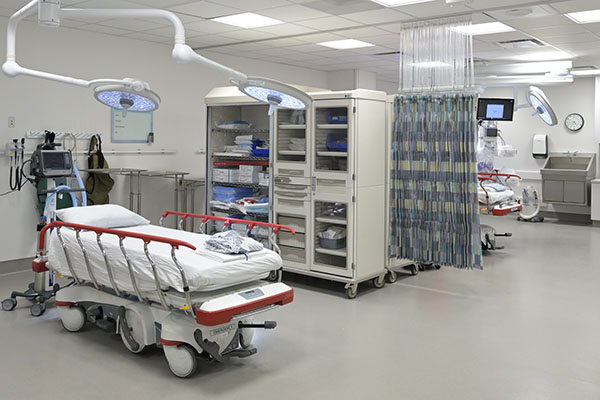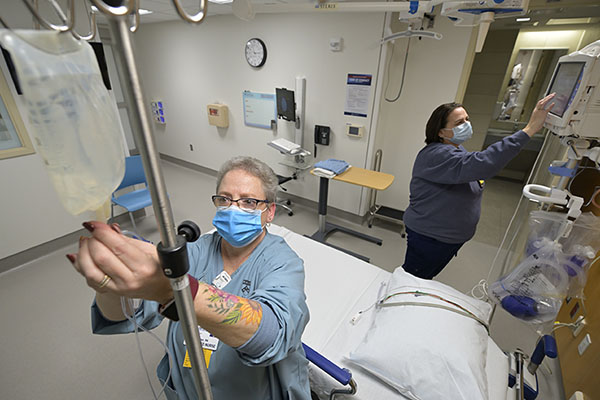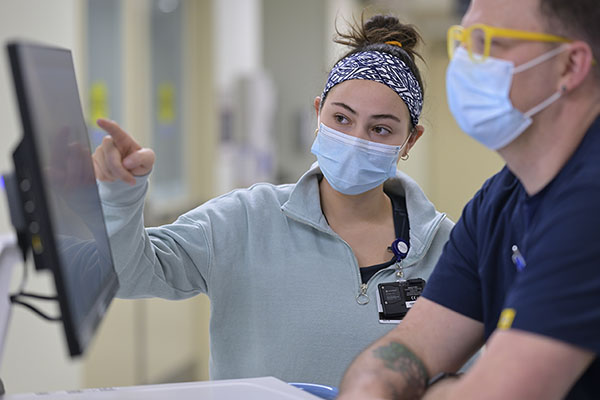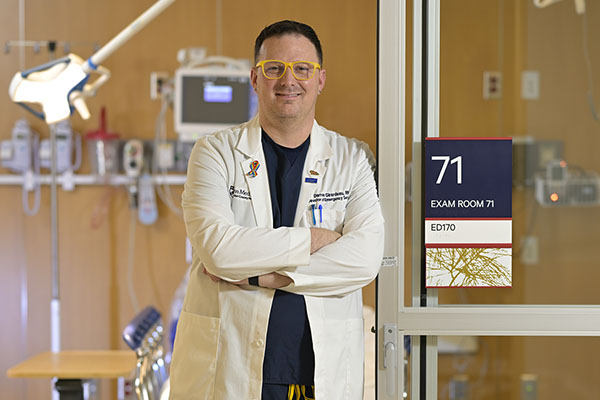
FRONT LINE OF CARE: The dedicated members of our Emergency Department take a moment ot enjoy their new work environment.
An extensive renovation of Chester County Hospital's Emergency Department has been completed, and it couldn't be a moment too soon. Visits to the Emergency Department have increased over the last several years. That trend will likely intensify in the wake of recent shifts in Chester County's healthcare landscape.
A 26,000-square-foot expansion of the department was completed last spring. Since then, the unit has undergone a renovation that occurred in phases to ensure patient access and care were not impacted. Now complete, the project, which is part of the largest expansion in the hospital's history, will have spanned three years.
In November, Darren Girardeau, MSN, BM, RN, PHRN, CCRN, CEN, Director of Emergency Services at the hospital, said the clean lines and new streams of natural light had already helped lift morale among a staff that's endured a steady succession of construction-related obstacles to its daily workflow. This is on top of the demands of a pandemic that's now in its third year.
"It's created a more pleasant environment for both our staff and patients," he shared.
Increased Capacity

New Resuscitation Bay, which allows full operating capacity.
With the completion of the renovation, 10 more beds will become available, bringing the department's total to 43. These include specialty exam rooms for the most vulnerable patients.
"The number of beds has been an issue for us not only because we're seeing more patients these days but also because the cases we treat, on average, have become more complex since we became part of Penn Medicine," shared Diana Kane, MD, FAAEM, Chairperson and Medical Director of Emergency Medicine at the hospital. She's been a doctor in Chester County Hospital’s Emergency Department for the last 21 years. "We've become a stop for local patients who require highly specialized care or surgeries. Some, we admit and treat here. Others may be transferred to one of our sister hospitals."

The Emergency Department has also experienced an increase in patients who are there seeking mental health services, since most long-term treatment programs across the region are at capacity. Girardeau said the department added staff during the first phase of the renovation because the department was divided by construction into two distinct parts. This essentially forced it to function as such. Now that more beds are available, additional staff have been added and the space is again contiguous.
"This country is facing a mental health crisis, and I think every ER is feeling the strain of it, including ours. Patients who are here for mental health-related issues are, in some cases, here for 12 to 13 days before an inpatient bed opens up for them at another facility," said Girardeau.
Streamlined Workflows

Previously, the beds in the department were divided only by curtains. Now, each is behind a closed door, which will help enhance privacy and, Kane said, reduce the risk of infection. Two of the four new resuscitation bays can also be used as negative pressure rooms. Within these, the department can isolate people with airborne diseases, such as COVID-19, flu, or tuberculosis. A machine pulls air into the room, then filters it before releasing it outside.
Prior to the renovation, the Emergency Department didn't have specialty care areas of any kind.
"It wasn't a barrier for us. We could take care of anyone in the department at any time," Girardeau shared. "But with the resuscitation bays, we'll have at our fingertips all the equipment we need to treat any critically ill patient."
The new department also features a less centralized floorplan compared to the former unit. A single nurses station has been replaced by multiple, smaller stations spaced throughout the department.
"Even now, there's a definite flow about the department," Kane added. "I think everyone feels more in touch, even if we're more spread out than we've ever been."
The doctors occupy an all-glass office in the middle of the floor that they've dubbed "The Fishbowl".” Within it, they have unobstructed views of all the resuscitation bays. Just as critically, the nurses can easily see who's in the fishbowl from almost anywhere on the floor, expediting the process of having a doctor review test results.
Enhanced Safety

In an environment where there's often a palpable sense of urgency, Girardeau said hospital leaders, himself included, were concerned by how the department's enhanced security features would be received. Since March 2020, the Emergency Department has been supervised by a security officer 24/7. Everyone who enters the department must also pass through a metal detector and x-ray security screening.
Girardeau says it was apparent almost immediately that their fears were unfounded.
Most visitors will probably only ever notice the more spacious waiting area (complete with access to a new bistro) and exam rooms. But all around them, subtle and pronounced changes are positioning providers to be even better prepared when they're thrust into action.

"Our staff felt safer right from the start, and the majority of our patients have commented that they feel safer, too." - Darren Girardeau, MSN, BM, RN, PHRN, CCRN; Director of Emergency Services